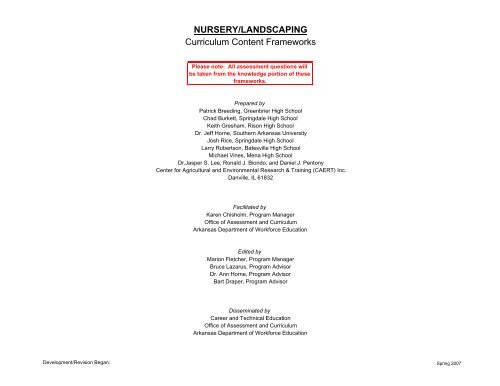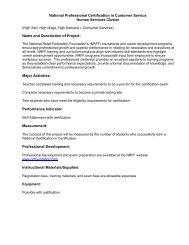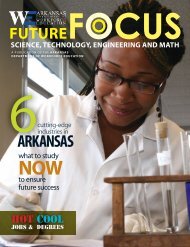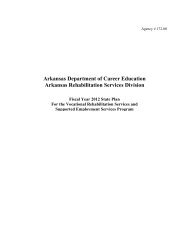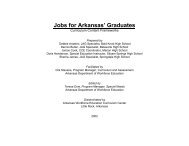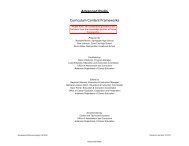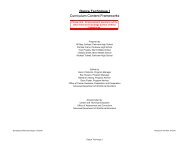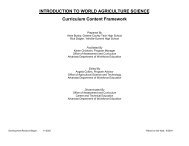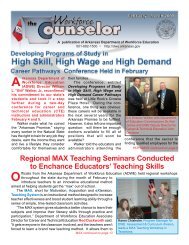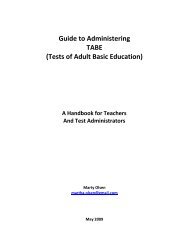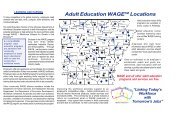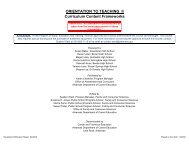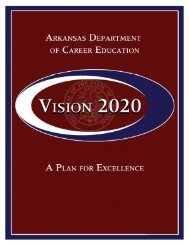Nursery/Landscape - Arkansas Department of Career Education
Nursery/Landscape - Arkansas Department of Career Education
Nursery/Landscape - Arkansas Department of Career Education
You also want an ePaper? Increase the reach of your titles
YUMPU automatically turns print PDFs into web optimized ePapers that Google loves.
NURSERY/LANDSCAPING<br />
Curriculum Content Frameworks<br />
Please note: All assessment questions will<br />
be taken from the knowledge portion <strong>of</strong> these<br />
frameworks.<br />
Prepared by<br />
Patrick Breeding, Greenbrier High School<br />
Chad Burkett, Springdale High School<br />
Keith Gresham, Rison High School<br />
Dr. Jeff Horne, Southern <strong>Arkansas</strong> University<br />
Josh Rice, Springdale High School<br />
Larry Robertson, Batesville High School<br />
Michael Vines, Mena High School<br />
Dr.Jasper S. Lee, Ronald J. Biondo, and Daniel J. Pentony<br />
Center for Agricultural and Environmental Research & Training (CAERT) Inc.<br />
Danville, IL 61832<br />
Facilitated by<br />
Karen Chisholm, Program Manager<br />
Office <strong>of</strong> Assessment and Curriculum<br />
<strong>Arkansas</strong> <strong>Department</strong> <strong>of</strong> Workforce <strong>Education</strong><br />
Edited by<br />
Marion Fletcher, Program Manager<br />
Bruce Lazarus, Program Advisor<br />
Dr. Ann Horne, Program Advisor<br />
Bart Draper, Program Advisor<br />
Disseminated by<br />
<strong>Career</strong> and Technical <strong>Education</strong><br />
Office <strong>of</strong> Assessment and Curriculum<br />
<strong>Arkansas</strong> <strong>Department</strong> <strong>of</strong> Workforce <strong>Education</strong><br />
Development/Revision Began:<br />
Spring 2007
Curriculum Content Frameworks<br />
<strong>Nursery</strong>/Landscaping<br />
Grade Levels: 10, 11, 12<br />
Prerequisite: Agriculture Science and Technology<br />
Course Code: 491330<br />
or Agriculture Science<br />
Course Description: This course covers the production <strong>of</strong> plants, shrubs, and ornamental trees for transplanting to landscape designs. Propagation, designing plans,<br />
installation, maintenance, transportation, and careers are included in the curriculum.<br />
Table <strong>of</strong> Contents<br />
Page<br />
Unit 1: Introduction to <strong>Nursery</strong> and Landscaping Industry 1<br />
Unit 2: Safety in <strong>Nursery</strong>/<strong>Landscape</strong> 2<br />
Unit 3: <strong>Landscape</strong> Process 3<br />
Unit 4: <strong>Landscape</strong> Design 4<br />
Unit 5: Plant Selection 6<br />
Unit 6: <strong>Landscape</strong> Contracting 7<br />
Unit 7: <strong>Landscape</strong> Installation 8<br />
Unit 8: <strong>Landscape</strong> Maintenance 9<br />
Glossary 10<br />
<strong>Nursery</strong>/Landscaping
<strong>Nursery</strong>/Landscaping<br />
1<br />
Unit 1: Introduction to <strong>Nursery</strong> and Landscaping Industry<br />
Hours: 5<br />
Terminology: Aesthetic, Entrepreneurship, Hydrozoning, <strong>Landscape</strong> architect, <strong>Landscape</strong> contractor, <strong>Landscape</strong> designer, <strong>Landscape</strong> industry, <strong>Landscape</strong> management, Landscaping,<br />
<strong>Nursery</strong>, <strong>Nursery</strong> industry, <strong>Nursery</strong>/Landscaping CDE, Ornamental horticulture, Placement, Pr<strong>of</strong>iciency, Xeriscaping<br />
CAREER and TECHNICAL SKILLS<br />
What the Student Should be Able to Do<br />
ACADEMIC and WORKPLACE SKILLS<br />
What the Instruction Should Reinforce<br />
Knowledge<br />
Application<br />
Skill Group<br />
Skill<br />
1.1 Define terminology<br />
1.1.1 Prepare a list <strong>of</strong> terms with definitions Foundation Reading<br />
Description<br />
Comprehends written information for main ideas<br />
[1.3.7]<br />
Writing<br />
Applies/Uses technical words and concepts<br />
[1.6.4]<br />
Applies a mathematical formula to solve a<br />
problem [1.1.3]<br />
1.2 Identify the economic scope <strong>of</strong> 1.2.1 Search the Internet for current data Foundation Arithmetic/<br />
the nursery/landscaping industry on the economic scope <strong>of</strong> the nursery/<br />
Mathematics<br />
in the United States<br />
landscaping industry and prepare a<br />
report<br />
Personal<br />
Organizational Comprehends the organization’s modes <strong>of</strong><br />
Management Effectiveness operation [3.3.5]<br />
1.3 Discuss careers available in the 1.3.1 Research a career in the nursery and Foundation Reading<br />
Applies information to job performance [1.3.4]<br />
nursery and landscaping<br />
industry<br />
landscaping industry to determine<br />
educational requirements, working<br />
conditions and salary<br />
Uses standard occupational resource materials<br />
[1.3.22]<br />
Personal<br />
Management<br />
1.4 Discuss the purpose <strong>of</strong> 1.4.1 Evaluate landscapes in the area<br />
Foundation Speaking<br />
landscaping<br />
Thinking<br />
Reasoning<br />
1.5 Explain the basic principles <strong>of</strong> 1.5.1 Identify materials used in the xeriscaping Foundation Writing<br />
xeriscaping<br />
process<br />
Thinking<br />
<strong>Career</strong> Awareness,<br />
Development, and<br />
Mobility<br />
Problem Solving<br />
1.6 List the FFA opportunities 1.6.1 Participate in FFA activities related to Foundation Speaking<br />
available to students interested nursery/landscaping<br />
in nursery and landscape<br />
management<br />
Personal<br />
Management<br />
<strong>Career</strong> Awareness,<br />
Development and<br />
Mobility<br />
Develops skills to locate, evaluate, and interpret<br />
career information [3.1.4]<br />
Identifies education and training needed to<br />
achieve goals [3.1.8]<br />
Asks questions to obtain information [1.5.4]<br />
Sees relationship between two or more ideas,<br />
objects, or situations [4.5.5]<br />
Applies/Uses technical words and concepts<br />
[1.6.4]<br />
Comprehends ideas and concepts related to<br />
xeriscaping [4.4.1]<br />
Communicates a thought, idea, or fact in spoken<br />
form [1.5.5]<br />
Sets well-defined and realistic personal/career<br />
goals (short-term and long-term) [3.1.11]
<strong>Nursery</strong>/Landscaping<br />
2<br />
Terminology: Accident, Hazard, Material Safety Data Sheet (MSDS), Risk, Safety<br />
Unit 2: Safety in <strong>Nursery</strong>/<strong>Landscape</strong><br />
Hours: 5<br />
CAREER and TECHNICAL SKILLS<br />
What the Student Should be Able to Do<br />
ACADEMIC and WORKPLACE SKILLS<br />
What the Instruction Should Reinforce<br />
Knowledge<br />
Application<br />
Skill Group<br />
2.1 Define terminology<br />
2.1.1 Prepare a list <strong>of</strong> terms with definitions Foundation Reading<br />
Writing<br />
2.2 Discuss the meaning and<br />
importance <strong>of</strong> safety and safe<br />
2.2.1 Relate examples <strong>of</strong> safety hazards in<br />
nursery/landscaping, including equipment<br />
Foundation Reading<br />
work in nursery/landscaping<br />
used in crop production and the inputs<br />
Speaking<br />
applied to plants such as pesticides and<br />
fertilizers<br />
2.2.2 Name examples <strong>of</strong> accidents that have<br />
occurred locally in nursery/landscaping Personal<br />
Management Skills<br />
2.3 Identify hazards in<br />
2.3.1 Survey hazardous situations in local Foundation Reading<br />
nursery/landscaping<br />
nursery/landscaping facilities; prescribe the<br />
appropriate safety measures to be taken<br />
and propose ways <strong>of</strong> eliminating/ reducing Personal<br />
the risk <strong>of</strong> these hazards<br />
Management Skills<br />
Skill<br />
Integrity/Honesty/<br />
Work Ethic<br />
Integrity/Honesty/<br />
Work Ethic<br />
Description<br />
Comprehends written information for main ideas<br />
[1.3.7]<br />
Applies/Uses technical words and concepts<br />
[1.6.4]<br />
Distinguishes between fact and opinion [1.3.11]<br />
Asks questions to obtain information [1.5.4]<br />
Communicates a thought, idea, or fact in spoken<br />
form [1.5.5]<br />
Complies with safety and health rules in a given<br />
work environment [3.2.2]<br />
Analyzes and applies what has been read to<br />
specific task [1.3.2]<br />
Complies with safety and health rules in a given<br />
work environment [3.2.2]<br />
2.3.2<br />
2.4 Describe the importance <strong>of</strong> 2.4.1<br />
personal safety in<br />
nursery/landscaping<br />
2.4.2<br />
Develop a list <strong>of</strong> practices to reduce risk<br />
when working with plants<br />
Identify and properly use appropriate PPE<br />
in nursery/landscaping<br />
Calculate the cost <strong>of</strong> PPE for an individual<br />
involved in nursery/landscaping<br />
Foundation<br />
Interpersonal<br />
Arithmetic/<br />
Mathematics<br />
Negotiation<br />
Calculates dollar amounts [1.1.7]<br />
Works to resolve conflict between two or more<br />
individuals [2.5.3]<br />
2.4.3 Work together with others to promote Thinking<br />
safety in nursery/landscaping<br />
Problem Solving<br />
Comprehends ideas and concepts related to<br />
safety with animals [4.4.1]<br />
2.4.4<br />
Take a test on nursery/landscaping safety<br />
before beginning work with plants
<strong>Nursery</strong>/Landscaping<br />
3<br />
Unit 3: <strong>Landscape</strong> Process<br />
Hours: 5<br />
Terminology: Base plan, Client, Contour interval, Contour lines, Family (client) inventory survey, Family living area, Final plans, Functional diagrams, Outdoor living area, Preliminary<br />
designs, Public area, Service area, Site analysis, Slope, Terrain, Topography<br />
CAREER and TECHNICAL SKILLS<br />
What the Student Should be Able to Do<br />
ACADEMIC and WORKPLACE SKILLS<br />
What the Instruction Should Reinforce<br />
Knowledge<br />
Application<br />
Skill Group Skill Description<br />
3.1 Define terminology 3.1.1 Prepare a list <strong>of</strong> terms with definitions Foundation Reading<br />
Comprehends written information for main ideas<br />
[1.3.7]<br />
Writing<br />
Applies/Uses technical words and concepts<br />
[1.6.4]<br />
3.2 List features by which a site can 3.2.1 Complete a site analysis Foundation Writing<br />
Analyzes data, summarizes results, and makes<br />
be evaluated<br />
conclusions [1.6.2]<br />
Thinking<br />
Creative Thinking<br />
3.3 Describe the content and use <strong>of</strong> 3.3.1 Use a family (client) inventory survey in Foundation Writing<br />
a family (client) inventory survey preparing a landscape design<br />
Thinking<br />
Creative Thinking<br />
3.4 Identify indoor and outdoor use 3.4.1 Apply knowledge <strong>of</strong> the indoor areas to a Foundation Reading<br />
areas<br />
landscape design<br />
Creates new design by applying criteria specified<br />
in information sheet [4.1.3]<br />
Analyzes data, summarizes results, and makes<br />
conclusions [1.6.2]<br />
Creates new design by applying criteria specified<br />
in information sheet [4.1.3]<br />
Identifies relevant details, facts, and<br />
specifications [1.3.16]<br />
3.4.2 Organize the landscape design by use Thinking<br />
areas (public area, service area, outdoor<br />
living area)<br />
Creative Thinking<br />
Reshapes goals in ways that reveal new<br />
possibilities [4.1.9]
<strong>Nursery</strong>/Landscaping<br />
4<br />
Unit 4: <strong>Landscape</strong> Design<br />
Hours: 10<br />
Terminology: Balance, Color, Computer Aided Design (CAD), Elevation view, Focalization <strong>of</strong> interest, Form, Foundation planting, Hardscape, Incurve, <strong>Landscape</strong> design, Line, Masses,<br />
Outcurve, Perspective, Plan view, Proportion, Rhythm and line, Simplicity, Subsoil, Texture, Topsoil, Unity, Voids<br />
CAREER and TECHNICAL SKILLS<br />
What the Student Should be Able to Do<br />
ACADEMIC and WORKPLACE SKILLS<br />
What the Instruction Should Reinforce<br />
Knowledge<br />
Application<br />
4.1 Define terminology<br />
4.1.1 Prepare a list <strong>of</strong> terms with definitions Foundation Reading<br />
Skill Group Skill Description<br />
Comprehends written information for main ideas<br />
[1.3.7]<br />
4.2 Perform measurements and 4.2.1<br />
duplicate angles<br />
Read an architect’s scale and an<br />
engineer’s scale<br />
Foundation<br />
Writing<br />
Arithmetic/<br />
Mathematics<br />
Applies/Uses technical words and concepts<br />
[1.6.4]<br />
Calculates measurements taken from measuring<br />
devices [1.1.9]<br />
4.2.2<br />
Use a scale in preparing a landscape<br />
design<br />
Personal<br />
Management<br />
<strong>Career</strong> Awareness,<br />
Development, and<br />
Mobility<br />
4.3 Identify the drafting tools <strong>of</strong> the 4.3.1 Draw a landscape design using traditional Foundation Reading<br />
landscape designer (drawing<br />
tools<br />
board, T-square, drawing paper,<br />
trash paper, drafting tape,<br />
drawing pencils, erasure shield,<br />
Personal<br />
Organization<br />
triangles, architect’s scale,<br />
Effectiveness<br />
engineer’s scale, circle<br />
template, French curves,<br />
lettering instrument)<br />
4.4 Distinguish between the plan, 4.4.1 Use plan, elevation, and perspective views Foundation Reading<br />
elevation, and perspective<br />
to illustrate a landscape design<br />
views <strong>of</strong> landscape proposals<br />
Thinking<br />
Seeing Things in the<br />
Mind’s Eye<br />
4.5 Describe the basic principles 4.5.1 Apply principles <strong>of</strong> design to a landscape Foundation Speaking<br />
that lead to good design<br />
plan<br />
(balance, focalization <strong>of</strong> interest,<br />
proportion, rhythm, simplicity,<br />
unity)<br />
Thinking<br />
Reasoning<br />
Analyzes own knowledge, skills, and ability<br />
[3.1.2]<br />
Locates pertinent information in documents such<br />
as manuals, graphs, and schedules to perform<br />
tasks [1.3.18]<br />
Applies knowledge to implement work-related<br />
system or practice [3.3.4]<br />
Analyzes and applies what has been read to<br />
specific task [1.3.3]<br />
Visualizes a system’s operation from schematics<br />
[4.6.2]<br />
Communicates a thought, idea, or fact in spoken<br />
form [1.5.5]<br />
Comprehends ideas and concepts related to<br />
landscape design [4.5.2]
<strong>Nursery</strong>/Landscaping<br />
5<br />
CAREER and TECHNICAL SKILLS<br />
What the Student Should be Able to Do<br />
ACADEMIC and WORKPLACE SKILLS<br />
What the Instruction Should Reinforce<br />
Knowledge<br />
Application Skill Group Skill Description<br />
4.6 Identify elements <strong>of</strong> design; line, 4.6.1 Classify landscape plants based on their Foundation Reading<br />
form, texture, color<br />
line, form, texture, and color<br />
Identifies relevant details, facts, and<br />
specifications [1.3.16]<br />
Interprets drawings to obtain factual information<br />
[1.3.17]<br />
Thinking<br />
Reasoning<br />
Sees relationship between two or more ideas,<br />
objects, or situations. [4.5.5]
<strong>Nursery</strong>/Landscaping<br />
6<br />
Unit 5: Plant Selection<br />
Hours: 10<br />
Terminology: Annual, Balled & Burlapped, Bare-rooted plant, Bedding plants, Biennials, Botanical name, Branching habits, Bulb, Canopy, Common name, Containerized/container grown,<br />
Cultivar, Exotic plants, Fibrous, Foundation planting, Genus, Hardiness, Hedge, Herbaceous, Microclimate, Native plants, Naturalized plants, Ornamental grasses, Perennials, Root<br />
systems, Silhouette, Species, Specimen plant, Tap root, Tree, Variety, Vine, Woody plants<br />
CAREER and TECHNICAL SKILLS<br />
What the Student Should be Able to Do<br />
ACADEMIC and WORKPLACE SKILLS<br />
What the Instruction Should Reinforce<br />
Knowledge<br />
Application<br />
5.1 Define terminology<br />
5.1.1 Prepare a list <strong>of</strong> terms with definitions Foundation Reading<br />
Skill Group Skill Description<br />
Comprehends written information for main ideas<br />
[1.3.7]<br />
Writing<br />
5.2 Explain plant nomenclature 5.2.1 Use Latin and common names for Foundation Reading<br />
landscape plants<br />
Applies/Uses technical words and concepts<br />
[1.6.4]<br />
Applies information and concepts derived from<br />
printed materials [1.3.3]<br />
Writing<br />
5.3 Describe the factors relevant to 5.3.1 Select plants for the landscape based on Foundation Speaking<br />
proper plant selection; function, function, environmental, messiness,<br />
environmental, messiness,<br />
ornamental characteristics, pest resistance,<br />
ornamental characteristics, pest safety, soil<br />
resistance, safety, soil<br />
Thinking<br />
Applies/Uses technical words and concepts<br />
[1.6.4]<br />
Communicates a thought, idea, or fact in spoken<br />
form [1.5.5]<br />
Decision Making Demonstrates decision-making skills [4.2.4]<br />
5.4 Explain the seasonal changes in 5.4.1 Select seasonal plants for a landscape Foundation Speaking<br />
a landscape<br />
Thinking<br />
5.5 Describe the uses and 5.5.1 Design a flower border<br />
Foundation Science<br />
limitations <strong>of</strong> flowers in a<br />
landscape design<br />
Thinking<br />
5.6 Discuss the factors used in the 5.6.1 Select turfgrass best suited for a landscape Foundation Writing<br />
comparison <strong>of</strong> different<br />
use<br />
turfgrasses<br />
Thinking<br />
Creative Thinking<br />
Problem Solving<br />
Problem Solving<br />
Participates in conversation, discussion, and<br />
group presentations [1.5.8]<br />
Finds new ways <strong>of</strong> dealing with existing<br />
problems/situations [4.1.5]<br />
Applies a scientific principle to solve a problem<br />
[1.4.8]<br />
Draws conclusions from observations, evaluates<br />
conditions, and gives possible solutions [4.4.5]<br />
Presents answers/conclusions in a clear and<br />
understandable form [1.6.13]<br />
Demonstrates logical reasoning in reaching a<br />
conclusion [4.4.2]
<strong>Nursery</strong>/Landscaping<br />
7<br />
Unit 6: <strong>Landscape</strong> Contracting<br />
Hours: 5<br />
Terminology: Bid, Contract, Contractor, Estimate, Estimator, Specifications, Subcontractor, Take-<strong>of</strong>f<br />
CAREER and TECHNICAL SKILLS<br />
What the Student Should be Able to Do<br />
ACADEMIC and WORKPLACE SKILLS<br />
What the Instruction Should Reinforce<br />
Knowledge<br />
Application<br />
Skill Group<br />
Skill<br />
6.1 Define terminology<br />
6.1.1 Prepare a list <strong>of</strong> terms with definitions Foundation Reading<br />
Description<br />
Comprehends written information for main ideas<br />
[1.3.7]<br />
6.2 Determine calculations needed 6.2.1<br />
for landscape take-<strong>of</strong>fs<br />
Calculate landscape take-<strong>of</strong>fs<br />
Foundation<br />
Writing<br />
Arithmetic/<br />
Mathematics<br />
Applies/Uses technical words and concepts<br />
[1.6.4]<br />
Applies addition, subtraction, multiplication, and<br />
division to real-world situations [1.1.1]<br />
Thinking<br />
6.3 Describe estimates and bids 6.3.1 Create an estimate for a landscape project Foundation Writing<br />
associated with landscape<br />
projects<br />
6.3.2 Develop a bid for a landscape project<br />
Interpersonal<br />
Problem Solving<br />
Customer Service<br />
Draws conclusions from observations, evaluates<br />
conditions, and gives possible solutions [4.4.5]<br />
Produces neat, legible document from typewriter<br />
or computer [1.6.15]<br />
Works with customers to satisfy their<br />
expectations [2.3.9]
<strong>Nursery</strong>/<strong>Landscape</strong><br />
8<br />
Unit 7: <strong>Landscape</strong> Installation<br />
Hours: 10<br />
Terminology: Antidesiccants, Calibration, Cut, Discharge rate, Drainage, Drip tubing, Emitter, Fill, Grading, Humus, Loam, Plugs, Precipitation rate, Rhizome, Seed analysis label,<br />
Sodding, Soil texture, Spray pattern, Sprigs, Sprinkler head, Sprinkler irrigation, Stolonizing, Stolons, Trickle irrigation, Turf<br />
CAREER and TECHNICAL SKILLS<br />
What the Student Should be Able to Do<br />
ACADEMIC and WORKPLACE SKILLS<br />
What the Instruction Should Reinforce<br />
Knowledge<br />
Application<br />
Skill Group<br />
7.1 Define terminology 7.1.1 Prepare a list <strong>of</strong> terms with definitions Foundation Reading<br />
Writing<br />
7.2 Identify tools used in the 7.2.1 Use the appropriate tools for different Foundation Reading<br />
installation <strong>of</strong> landscape plants<br />
landscape jobs<br />
Thinking<br />
Decision Making<br />
7.3 Describe accepted methods <strong>of</strong> 7.3.1 Prepare a site for installation<br />
Foundation Speaking<br />
lawn installation/renovation<br />
7.3.2 Sod a site<br />
Thinking<br />
Knowing How to<br />
7.3.3 Sprig a site<br />
Learn<br />
7.3.4 Seed a site<br />
7.4 Demonstrate proper plant 7.4.1 Install trees and shrubs<br />
Foundation Speaking<br />
installation methods<br />
7.4.2 Install ground covers and flowers<br />
Thinking<br />
Knowing How to<br />
Learn<br />
7.5 Distinguish between sprinkler 7.5.1 Design an irrigation system<br />
Foundation Listening<br />
and trickle irrigation<br />
7.5.2 Set up an irrigation system<br />
Thinking<br />
Problem Solving<br />
Skill<br />
Description<br />
Comprehends written information for main ideas<br />
[1.3.7]<br />
Applies/Uses technical words and concepts<br />
[1.6.4]<br />
Identifies relevant details, facts, and<br />
specifications [1.3.16]<br />
Demonstrates decision-making skills [4.2.4]<br />
Applies/Uses technical terms as appropriate to<br />
audience [1.5.2]<br />
Uses available resources to acquire new skills or<br />
improve skills [4.3.4]<br />
Applies/Uses technical terms as appropriate to<br />
audience [1.5.2]<br />
Uses available resources to acquire new skills or<br />
improve skills [4.3.4]<br />
Comprehends ideas and concepts related to<br />
<strong>Landscape</strong> Installation [1.2.1]<br />
Draws conclusions from what is read and gives<br />
possible solutions [4.4.5]
<strong>Nursery</strong>/<strong>Landscape</strong><br />
9<br />
Unit 8: <strong>Landscape</strong> Maintenance<br />
Hours: 10<br />
Terminology: Aeration, Crotch, Crown, Dormancy, Girdling, Graft, Heading back, Heaving, Herbicide, Jump cutting, Lead branch, Mulch, Pruning, Reel mower, Rotary mower, Scaffold<br />
branches, Scion, Stock, String trimmer, Suckers, Sunscald, Thinning out, Water sprouts, Weed, Windburn<br />
CAREER and TECHNICAL SKILLS<br />
What the Student Should be Able to Do<br />
ACADEMIC and WORKPLACE SKILLS<br />
What the Instruction Should Reinforce<br />
Knowledge<br />
Application<br />
Skill Group<br />
Skill<br />
8.1 Define terminology<br />
8.1.1 Prepare a list <strong>of</strong> terms with definitions Foundation Reading<br />
Description<br />
Comprehends written information for main ideas<br />
[1.3.7]<br />
Writing<br />
8.2 Discuss the importance <strong>of</strong> 8.2.1 Participate in a class discussion on the Foundation Speaking<br />
proper maintenance <strong>of</strong><br />
importance <strong>of</strong> landscape maintenance<br />
landscape<br />
Personal<br />
Management<br />
Organizational<br />
Effectiveness<br />
Applies/Uses technical words and concepts<br />
[1.6.4]<br />
Participates in conversation, discussion, and<br />
group presentations [1.5.8]<br />
Comprehends the organization’s modes <strong>of</strong><br />
operation [3.3.5]<br />
8.3 Describe the types <strong>of</strong> pruning 8.3.1 Demonstrate proper pruning techniques Foundation Reading<br />
Comprehends written specifications and applies<br />
them to a task [1.3.9]<br />
Thinking<br />
Decision Making<br />
8.4 Compare the methods <strong>of</strong> weed 8.4.1 Remove weeds from a landscape Foundation Writing<br />
control in the landscape<br />
8.4.2 Install a weed cloth<br />
Thinking<br />
Reasoning<br />
8.5 Identify tools used in landscape 8.5.1 Use the appropriate tools for different Foundation Reading<br />
maintenance<br />
landscape maintenance jobs<br />
Personal<br />
Management<br />
Organizational<br />
Effectiveness<br />
8.6 Discuss the maintenance <strong>of</strong> 8.6.1 Perform basic maintenance on tools Foundation Writing<br />
landscape tools<br />
8.6.2 Sharpen blades<br />
Interpersonal Coaching<br />
Considers risks when making a decision [4.2.3]<br />
Adapts notes to a proper form [1.6.1]<br />
Determines which conclusions are correct when<br />
given a set <strong>of</strong> facts and a set <strong>of</strong> conclusions<br />
Locates pertinent information in documents such<br />
as manuals, graphs, and schedules to perform<br />
Applies knowledge to implement work-related<br />
Organizes sentences into paragraphs [1.6.11]<br />
Helps others learn new skills [2.1.3]<br />
8.6.3 Maintain tools<br />
8.7 Discuss the proper techniques 8.7.1 Maintain landscape plants through proper Foundation Science<br />
needed to water, fertilize, edge, watering, fertilizing, edging, and mowing<br />
and mulch<br />
practices<br />
Solves practical problems using scientific<br />
methods and techniques [1.4.23]<br />
Thinking Problem Solving Comprehends ideas and concepts related to<br />
landscape maintenance [4.4.1]
<strong>Nursery</strong>/<strong>Landscape</strong><br />
10<br />
1. Aesthetic – attractive to the human senses<br />
2. Entrepreneurship – working for one’s self<br />
Glossary<br />
Unit 1: Introduction to <strong>Nursery</strong> and Landscaping Industry<br />
3. Hydrozoning – grouping plants on the basis <strong>of</strong> their water needs<br />
4. <strong>Landscape</strong> architect – a licensed pr<strong>of</strong>essional who practices landscape planning, usually on a scale larger than residential properties<br />
5. <strong>Landscape</strong> contractor – a pr<strong>of</strong>essional who carries out the installation <strong>of</strong> landscapes<br />
6. <strong>Landscape</strong> designer – a pr<strong>of</strong>essional who devotes all or part <strong>of</strong> a work day to the design <strong>of</strong> landscapes<br />
7.<br />
<strong>Landscape</strong> industry – a service based industry which serves by fabricating environments where people can live, work, play, or just pass time; these environments are<br />
primarily outdoors or in interior settings that seek to suggest outdoors<br />
8. <strong>Landscape</strong> management – the extended care <strong>of</strong> existing landscapes, usually under terms <strong>of</strong> a contract<br />
9. Landscaping – a pr<strong>of</strong>ession involving the design, installation, and maintenance <strong>of</strong> the outdoor human living environment<br />
10. <strong>Nursery</strong> – any place where plants, shrubs, or trees are grown either for transplanting or grafting stocks; a group <strong>of</strong> young plants or trees in a plantation<br />
11. <strong>Nursery</strong> industry – a service based industry which serves by providing plants, materials, and supplies for businesses and/or individuals<br />
12. <strong>Nursery</strong>/Landscaping CDE – an FFA <strong>Career</strong> Development Event that allows for competition in the different aspects <strong>of</strong> <strong>Nursery</strong>/Landscaping<br />
13. Ornamental horticulture – the practice <strong>of</strong> using plants and other materials for decorative purposes<br />
14. Placement – working for someone else<br />
15. Pr<strong>of</strong>iciency – an FFA award for students conducting an SAE<br />
16. Xeriscaping – techniques <strong>of</strong> landscaping that conserve water
<strong>Nursery</strong>/<strong>Landscape</strong><br />
11<br />
Unit 2: Safety in <strong>Nursery</strong>/<strong>Landscape</strong><br />
1. Accident – an event that happens unexpectedly or unintentionally<br />
2. Hazard – exposure to danger or harm<br />
3. Material Safety Data Sheet (MSDS) – a sheet containing information about the safe use <strong>of</strong> a chemical and the steps to take in case <strong>of</strong> an accident<br />
4. Risk – the chance that an accident might occur during a research project<br />
5. Safety – a state <strong>of</strong> being free <strong>of</strong> danger and injury
<strong>Nursery</strong>/<strong>Landscape</strong><br />
12<br />
Unit 3: <strong>Landscape</strong> Process<br />
1 Base plan – a scaled drawing <strong>of</strong> a home with doors, windows, existing hardscapes, property lines and easements<br />
2. Client – a customer or receiver <strong>of</strong> services<br />
3. Contour interval – the vertical distance between contour lines<br />
4. Contour lines – broken lines found on a topographic map; they represent vertical elevation<br />
5. Family (client) inventory survey – a form on which the client provides information that relates to the landscape project<br />
6.<br />
7.<br />
8.<br />
Family living area – the area <strong>of</strong> a landscape that usually is located toward the rear and side <strong>of</strong> a house; it is connected to the family living area <strong>of</strong> the house and is<br />
where the family relaxes and entertains guests; it is developed for full or partial privacy<br />
Final plans – master drawing <strong>of</strong> a landscape design project that is graphically detailed and completely specific; it incorporates all <strong>of</strong> the suggestions and reactions <strong>of</strong><br />
the client to earlier diagrams; these plans will be used for installation <strong>of</strong> the landscape<br />
Functional diagrams – loosely drawn freeform drawings used to begin the arrangements <strong>of</strong> the client's site; these help the designer make important logical decisions<br />
concerning layout <strong>of</strong> the site, size requirements <strong>of</strong> each use area, circulation patterns, potential conflicts and the relationship <strong>of</strong> <strong>of</strong>f-site features to<br />
on-site areas<br />
9. Outdoor living area – the area <strong>of</strong> a landscape that is developed for privacy and should be accessible from the house<br />
10.<br />
11.<br />
Preliminary designs – the designer's first draft version <strong>of</strong> how each area <strong>of</strong> the landscape will be shaped; it is suitable for presenting to the client for review in order to<br />
obtain feedback<br />
Public area – the area <strong>of</strong> a landscape that is seen by everyone who drives or walks past; it is also the area through which everyone passes who enters a building or<br />
house; it should be connected to the public area <strong>of</strong> the house<br />
12. Service area – the area <strong>of</strong> a landscape which is used for service; it is usually screened from view and located near the kitchen or other indoor service area<br />
13.<br />
Site analysis – an accurate sketch <strong>of</strong> the site to be landscaped which includes everything currently on the site recorded as to it's relationship to everything else<br />
currently on the site<br />
14. Slope – a measurement that compares the horizontal length to the vertical rise or fall <strong>of</strong> land; the measurement can be determined from a topographic map<br />
15. Terrain – the rise and fall <strong>of</strong> the land<br />
16. Topography – a record <strong>of</strong> an area's terrain
<strong>Nursery</strong>/<strong>Landscape</strong><br />
13<br />
Unit 4: <strong>Landscape</strong> Design<br />
1. Balance – the even distribution <strong>of</strong> materials on opposite sides <strong>of</strong> a central axis; there are three kinds <strong>of</strong> balance: symmetric, asymmetric, and proximal/distal<br />
2. Color – the greatest visual impact <strong>of</strong> all design elements; its source is visible light; subdivided into warm and cool colors<br />
3. Computer Aided Design (CAD) – the use <strong>of</strong> computer hardware and s<strong>of</strong>tware to produce drawings<br />
4. Elevation view – a scaled drawing with two dimensions, one horizontal and one vertical<br />
5. Focalization <strong>of</strong> interest – principle <strong>of</strong> design that selects and positions visually strong items in the landscape composition<br />
6. Form – the three dimensional shape <strong>of</strong> a plant<br />
7. Foundation planting – placing plants around the foundation <strong>of</strong> the house; this s<strong>of</strong>tens the corners and blocks the view <strong>of</strong> the foundation<br />
8. Hardscape – design materials that are not living plant materials; the term usually is applied to the constructed materials <strong>of</strong> a landscape<br />
9. Incurve – the center <strong>of</strong> a corner planting bed and a natural focal point<br />
10.<br />
<strong>Landscape</strong> design – the pr<strong>of</strong>ession concerned with the planning and planting <strong>of</strong> outdoor space to secure the most desirable relationship between land forms,<br />
architecture, and plants to best meet human needs for function and beauty<br />
11. Line – the outline <strong>of</strong> plants, plant parts, and physical features<br />
12. Masses – solid vertical areas <strong>of</strong> plantings, buildings, walls, or land forms<br />
13. Outcurve – the sides <strong>of</strong> a corner planting<br />
14. Perspective – a drawing that permits multiple sides <strong>of</strong> an object to be seen in a single view; dimensions are not measurable<br />
15. Plan view – a measurable drawing seen as though the viewer's line <strong>of</strong> sight is perpendicular to the surface<br />
16. Proportion – principle <strong>of</strong> design concerned with the size relationships between all the features <strong>of</strong> the landscape<br />
17. Rhythm and line – principle <strong>of</strong> design; something is repeated at a standard interval, creating a rhythm; lines establish the shape and form <strong>of</strong> a landscape<br />
18. Simplicity – principle <strong>of</strong> design that makes the viewer comfortable in the landscape; does not imply simplistic<br />
19.<br />
Subsoil – that part <strong>of</strong> the soil pr<strong>of</strong>ile which lies below the usual plow depth without any specific limitation in depth or kind <strong>of</strong> material; a b horizon, the first change with<br />
depth in texture or structure<br />
20. Texture – the appearance <strong>of</strong> a plant in terms <strong>of</strong> coarseness or fineness, roughness or smoothness, heaviness or lightness, denseness or thinness
<strong>Nursery</strong>/<strong>Landscape</strong><br />
14<br />
21.<br />
Topsoil – surface soils and subsurface soils which presumably are fertile soils, rich in organic matter or humus debris; top soil is found in the uppermost soil layer<br />
called the a horizon<br />
22. Unity – principle <strong>of</strong> design in which all separate parts contribute to the creation <strong>of</strong> the total design<br />
23. Voids – the horizontal open areas <strong>of</strong> the landscape
<strong>Nursery</strong>/<strong>Landscape</strong><br />
15<br />
1. Annual – a plant that completes its life cycle in one growing season<br />
Unit 5: Plant Selection<br />
2.<br />
3.<br />
Balled & burlapped – a form <strong>of</strong> plant preparation in which a large part <strong>of</strong> the root system is retained in the soil ball; the ball is wrapped in burlap to facilitate handling<br />
during sale and transplanting<br />
Bare-rooted plant – a form <strong>of</strong> plant preparation in which all soil is removed from the root system; the plant is lightweight and easier to handle during sale and<br />
transplanting<br />
4. Bedding plants – herbaceous plants pre-seeded and grown in containers<br />
5. Biennials – a plant that lives for two growing seasons and dies<br />
6. Botanical name – the scientific name <strong>of</strong> plants which includes the genus and species<br />
7.<br />
Branching habits – a combination <strong>of</strong> the number <strong>of</strong> branches, the average size <strong>of</strong> branches, the flexibility <strong>of</strong> branches and the vertical or horizontal direction <strong>of</strong> their<br />
growth<br />
8. Bulb – a flowering perennial that survives the winter as a dormant fleshy storage structure<br />
9. Canopy – the collective term for the foliage <strong>of</strong> a tree<br />
10. Common name – the name by which a plant is known to the general public<br />
11.<br />
12.<br />
Containerized/container grown – a form <strong>of</strong> plant preparation for sale and transplanting; when purchased, the plant is growing with its root system intact within a<br />
plastic, metal, or tarpaper container<br />
Cultivar – group <strong>of</strong> organisms with distinguishing characteristics from other plants in a species, but does not transfer those characteristics to the <strong>of</strong>fspring through<br />
sexual reproduction<br />
13. Exotic plants – plants that have been introduced to an area by human beings, not nature<br />
14. Fibrous – type <strong>of</strong> root system that is composed <strong>of</strong> pr<strong>of</strong>usely branched roots with many lateral rootlets; the fine roots <strong>of</strong> grass<br />
15. Foundation planting – the planting next to a building that helps it blend more comfortably into the surrounding landscape<br />
16. Genus – members <strong>of</strong> this group have similar characteristics and relate to each other; first word in the scientific name<br />
17. Hardiness – the ability <strong>of</strong> a plant to survive through the winter season<br />
18. Hedge – a fence or barrier formed by bushes, shrubs, or small trees growing close together in a line, sometimes with interwoven branches used as a screen<br />
19. Herbaceous – a type <strong>of</strong> plant that is non-woody; it has no bark
<strong>Nursery</strong>/<strong>Landscape</strong><br />
16<br />
20. Microclimate – regions that provide atypical growing conditions<br />
21. Native plants – a plant that evolved naturally within a certain locale<br />
22. Naturalized plants – plants that were introduced to an area as an exotic plant, but which have adapted so well that it may appear to be native<br />
23. Ornamental grasses – grasses produced, planted, and maintained for their beauty; Liriope<br />
24. Perennials – a plant that lives more than two growing seasons; it usually is dormant during the winter<br />
25.<br />
Root systems – system used by plants for anchorage, uptake <strong>of</strong> nutrients, and storage <strong>of</strong> manufactured foods; these systems range from total tap root systems, with<br />
a large single root growing straight down into the soil, to full fibrous systems, with thousands <strong>of</strong> fine, hair like roots spreading out in all directions<br />
26. Silhouette – the outline <strong>of</strong> an object viewed as dark against a light background<br />
27. Species – a group <strong>of</strong> things that exhibit more similarities than the members <strong>of</strong> the genus; second word in a scientific name<br />
28. Specimen plant – a plant that displays outstanding form, texture, and color<br />
29. Tap root – root system composed <strong>of</strong> one main root which grows straight down into the soil<br />
30.<br />
31.<br />
Tree – any woody, perennial plant which normally has one well-defined stem and a definitely formed crown; it is usually considered to have a minimum height <strong>of</strong> 15<br />
feet<br />
Variety – a group <strong>of</strong> related plants that differs from other similar groups by characters too trivial or inconsistent to be recognized as a species; <strong>of</strong>ten any category <strong>of</strong><br />
lower rank in a species<br />
32. Vine – any woody or herbaceous plant that trails, climbs, or creeps as contrasted to those that stand without support<br />
33. Woody plants – any shrub, tree, or certain vines, as distinguished from herbaceous plants, which produces wood and has buds surviving above ground during the<br />
winter
<strong>Nursery</strong>/<strong>Landscape</strong><br />
17<br />
Unit 6: <strong>Landscape</strong> Contracting<br />
1. Bid – a fixed price placed on work to be done<br />
2. Contract – an agreement between two parties that is legally binding<br />
3. Contractor – party in contract with the client or the client's representatives<br />
4. Estimate – an approximation <strong>of</strong> the price that a customer will be charged for a landscape project<br />
5. Estimator – the individual usually assigned to do the landscape take-<strong>of</strong>f<br />
6. Specifications – written descriptions <strong>of</strong> landscape materials, work, and time schedules for a project<br />
7. Subcontractor – firm in contract with the prime contract holder to provide selected services for the accomplishments <strong>of</strong> a project<br />
8. Take-<strong>of</strong>f – the calculation <strong>of</strong> quantities from plans and specifications
<strong>Nursery</strong>/<strong>Landscape</strong><br />
18<br />
Unit 7: <strong>Landscape</strong> Installation<br />
1. Antidesiccants – a liquid sprayed on plants to reduce water loss, transplant shock, windburn, and sunscald<br />
2. Calibration – the adjustment <strong>of</strong> a piece <strong>of</strong> equipment so that it distributes a given material at the rate desired<br />
3. Cut – a grading practice that removes earth from a slope<br />
4.<br />
Discharge rate – the amount <strong>of</strong> water flowing from the irrigation system over a measured period <strong>of</strong> time, usually measured in gallons per minute<br />
or hour (gpm or gph)<br />
5. Drainage – the act <strong>of</strong> water passing through the root area <strong>of</strong> soil; soil is well drained if water disappears in 10 minutes or less from a shrub or tree planting<br />
6. Drip tubing – thin black tubing used for trickle irrigation<br />
7. Emitter – the device that functions as a sprinkler head for trickle irrigation<br />
8. Fill – a grading practice that adds earth to a slope or material used to bring an area to grade<br />
9. Grading – the moving <strong>of</strong> soil and the reshaping <strong>of</strong> the land<br />
10. Humus – created by decaying organic matter, it aids the soil in moisture retention<br />
11. Loam – soil that contains approximately equal amounts <strong>of</strong> clay, silt, and sand (a desirable condition)<br />
12. Plugs – small square, rectangle, or circle <strong>of</strong> sod cut about two inches thick used to reestablish a lawn<br />
13. Precipitation rate – the amount <strong>of</strong> water placed over a landscape area; it is measured in inches <strong>of</strong> water per hour<br />
14.<br />
Rhizome – an underground stem; new shoots are sent to the surface some distance out from the parent plant; each new plant develops its own root system and<br />
becomes independent <strong>of</strong> the parent plant<br />
15. Seed analysis label – a breakdown <strong>of</strong> the contents <strong>of</strong> the seed package on which it appears; must appear on every package <strong>of</strong> seeds sold<br />
16. Sodding – a method <strong>of</strong> lawn installation that uses strips <strong>of</strong> live, growing grass; it produces an immediate effect on the landscape, but is more costly than seeding<br />
17. Soil texture – the composition <strong>of</strong> a soil as determined by the proportion <strong>of</strong> sand, silt, and clay that it contains<br />
18. Spray pattern – the specific distribution pattern <strong>of</strong> a specific sprinkler head<br />
19. Sprigs – pieces <strong>of</strong> grass shoots; sprigs are commonly used to establish warm-season grass plantings<br />
20. Sprinkler head – the device through which water leaves the pipe and is propelled onto the lawn or plantings
<strong>Nursery</strong>/<strong>Landscape</strong><br />
19<br />
21. Sprinkler irrigation – water applied under pressure over the tops <strong>of</strong> plants<br />
22. Stolonizing – a form <strong>of</strong> sprigging where the sprigs are broadcast over the site and covered lightly with soil<br />
23. Stolons – stems that are horizontally above the ground; new plants develop from it and become independent <strong>of</strong> the parent plant<br />
24. Trickle irrigation – form <strong>of</strong> irrigation where the water is applied slowly over a longer period <strong>of</strong> time<br />
25. Turf – the plants in a ground cover and the soil in which the roots grow; a collection <strong>of</strong> grass plants that form a ground cover
<strong>Nursery</strong>/<strong>Landscape</strong><br />
20<br />
Unit 8: <strong>Landscape</strong> Maintenance<br />
1.<br />
Aeration – the addition <strong>of</strong> air into the soil; it is accomplished during soil conditioning with materials such as sand or peat moss; it can be encouraged in established<br />
lawns by the use <strong>of</strong> machines called aerators<br />
2. Crotch – the point on a tree at which two branches or a branch and the trunk meet<br />
3. Crown – the point at which the aboveground plant parts and the root systems meet<br />
4. Dormancy – a period <strong>of</strong> rest that perennial plants experience during the winter season; they continue to live, but have little or no growth<br />
5.<br />
Girdling – the complete removal <strong>of</strong> a strip <strong>of</strong> bark around the main stem <strong>of</strong> a plant; after girdling, the ability <strong>of</strong> nutrients to pass from roots to leaves is lost, causing the<br />
eventual death <strong>of</strong> the plant<br />
6. Graft – a man-made bond between two different plants, one selected for its aboveground qualities (scion) and the other for its below ground qualities (stock)<br />
7. Heading back – a pruning technique that shortens a shrub branch without totally removing it<br />
8.<br />
Heaving – an action that causes shallowly rooted plants, such as grasses, groundcovers, and bulbs, to be forced to the surface <strong>of</strong> the soil; the action results from<br />
repeated freezing and thawing <strong>of</strong> the soil surface<br />
9. Herbicide – a chemical used to kill weeds<br />
10. Jump cutting – a pruning technique for the removal <strong>of</strong> large limbs from trees with out stripping bark from the trunk; it involves a series <strong>of</strong> three cuts<br />
11. Lead branch – the most important branch <strong>of</strong> a tree; cannot be removed without destroying the distinctive shape <strong>of</strong> the tree<br />
12. Mulch – materials used around plants to reduce water loss, prevent weed growth, keep soil temperatures uniform, and prevent erosion<br />
13. Pruning – the removal <strong>of</strong> a portion <strong>of</strong> a plant for better shape or more fruitful growth<br />
14.<br />
15.<br />
Reel mower – a mower used for home, recreational, and commercial lawn maintenance; the blades rotate in the same direction as the wheels and cut the grass by<br />
pushing it against a non-rotating bed knife at the rear base <strong>of</strong> the mower<br />
Rotary mower – a mower used for home, recreational, and commercial lawn maintenance; the blades move like a ceiling fan, parallel to the surface <strong>of</strong> the lawn,<br />
cutting the grass <strong>of</strong>f as they revolve<br />
16. Scaffold branches – a lateral branch <strong>of</strong> a tree<br />
17. Scion – shoot portion <strong>of</strong> a tree<br />
18. Stock – root portion <strong>of</strong> a tree<br />
19. String trimmer – piece <strong>of</strong> equipment is used to trim grass and weeds in areas not accessible by a mower
<strong>Nursery</strong>/<strong>Landscape</strong><br />
21<br />
20. Suckers – a succulent branch that originates from the root system; the vegetation <strong>of</strong> suckers is abnormal and undesirable<br />
21.<br />
Sunscald – a temperature-induced form <strong>of</strong> winter injury; the winter sun thaws the aboveground plant tissue, causing it to lose water; the roots remain frozen, and<br />
thereby unable to replace the water; the result is drying <strong>of</strong> the tissue<br />
22. Thinning out – a pruning technique that removes a shrub branch at or near the growth <strong>of</strong> the plant<br />
23. Water sprouts – a succulent branch that grows from the trunk <strong>of</strong> a tree; the vegetation <strong>of</strong> water sprouts is abnormal and undesirable<br />
24. Weed – a plant growing where it is not wanted and with no economic value<br />
25. Windburn – drying out <strong>of</strong> plant tissue (especially evergreens) by the winter wind


